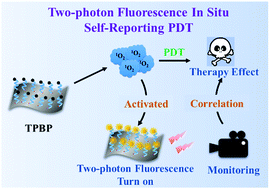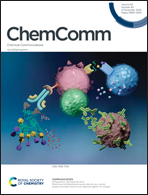A two-photon fluorescence self-reporting black phosphorus nanoprobe for the in situ monitoring of therapy response†
Abstract
The in situ and real-time supervision of reactive oxygen species (ROS) generated during photodynamic therapy (PDT) is of great significance for lessening nonspecific damage and guiding personalized therapy. However, photosensitizers frequently fail to deliver successful treatment accompanying the ROS-related imaging signals produced, impeding simple treatment outcome predictions and therapeutic schedule adjustments. Here, we report a two-photon fluorescence self-reporting strategy for the in situ and real-time monitoring of treatment response via a novel black phosphorus-based two-photon nanoprobe (TPBP). TPBP effectively generated singlet oxygen (1O2) under near-infrared laser irradiation for PDT, and 1O2 stimulated a two-photon molecule to emit fluorescence signals for feedback of 1O2 generation, which facilitated the regulation of treatment parameters to achieve precise and personalized medicine in deep tissue.



 Please wait while we load your content...
Please wait while we load your content...